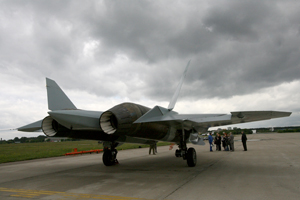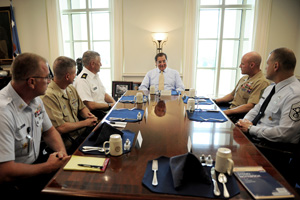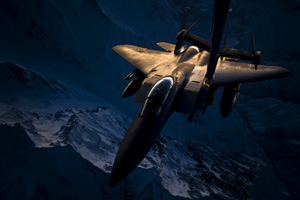The hunt is on for at least $400 billion in savings from the defense budget and for a new strategy to go with it.
In April, the Department of Defense dove into the biggest out-of-cycle review of defense strategy in almost 20 years. The review sprang from President Obama’s initiative to cut another $400 billion from the defense budget by 2023. During a major deficit reduction speech delivered at George Washington University on April 13, Obama applauded the Pentagon for “saving $400 billion in current and future spending. I believe we can do that again.”
Not only did Obama throw down the gauntlet for cuts, he opened the door for restructuring. “We need to not only eliminate waste and improve efficiency and effectiveness, … but conduct a fundamental review of America’s missions, capabilities, and our role in a changing world,” Obama continued. He will wait to “make specific decisions about spending” until after the review was complete.
 |
In future conflicts, the most important attribute of the F-22, such as the one illustrated above, may be its penetrating, survivable surveillance. (Photo illustration by Erik Simonsen) |
Few doubt money is the main motive. “It’s pretty darn serious when the answer is $400 billion,” said Thomas Donnelly of the American Enterprise Institute. But dollars alone won’t hack it. Defense Secretary Robert M. Gates’ successor, Leon E. Panetta, “will have to announce strategy-driven changes,” said Clark A. Murdock of the Center for Strategic and International Studies (CSIS).
For his part, Panetta said the review would not lead to the kind of hollow force he remembered from the 1970s. “I am determined notto repeat the mistakes of the past,” he said in early August. “We are asking ourselves: What are the essential missions our military must do to protect America and our way of life? What are the risks of the strategic choices we make? And what are the financial costs?”
The review marks an important moment for airpower writ large, and for the future direction of the Air Force.
All services are likely to shed capability. The question is, what essential missions will USAF keep?
The US is coming off a decade of building up land forces and equipment for counterinsurgency wars with uncontested airspace. Recent Pentagon reviews have danced around future security threats such as competition with China in the Pacific. Just two years ago DOD deliberately took on medium risk moves in major combat capabilities in order to focus on Iraq and Afghanistan.
Now the wind is shifting. The consensus from Washington’s top strategists is that the Pentagon must make tough choices about missions and not only programs. “We need to avoid just making the relatively easy decision, ‘Let’s just cut force structure,’” said Adm. Michael G. Mullen, Chairman of the Joint Chiefs of Staff.
With the 2011 review, the first hurdle will be contending with the lengthy list of missions for the military.
Hard Power
In the early 1990s, big force structure cuts were justified by reduced threats after the Cold War. Force planning centered on agile forces for two major theater wars. Since then, overseas taskings have grown and diversified. Military forces are deployed to counter terrorism, shape relationships with key countries and regions, and to defend the US homeland. “It’s not like the ’90s,” said Mullen. “The level of national security challenge is, from my perspective, near an all-time high.”
Officially, the Obama Administration has given no signs of backing off the broad global security commitments it has put forward. In fact, the 2010 National Security Strategy added requirements such as protecting cyberspace. It also explicitly emphasized the use of US military forces to prevent humanitarian disasters such as genocide—a policy that led directly to US airpower-led intervention with NATO in Libya.
Add humanitarian relief and the result is peak demand on force elements such as airlift. For example, on March 26, air mobility taskings soared with 123 C-17s flying missions for Iraq, Afghanistan, Libya, and relief to earthquake- and tsunami-devastated Japan.
Predictions on future strategy call for more airpower not less. The congressional panel chartered to critique the 2010 QDR did not reduce the mission list either. Global trends were “likely to place an increased demand on American ‘hard power’ to preserve regional balances; while diplomacy and development have important roles to play, the world’s first-order concerns will continue to be security concerns,” the panel wrote.
 |
AF-11, an Air Force version of the F-35, takes off on its first flight July 1. The Pentagon is keeping a careful eye on the F-35 program, which has been plagued by cost overruns and technical difficulties. (Lockheed Martin photo) |
Scholars note the long-range outlook is crowded with dangers. “The last 10 years have really clarified future conflict,” said Donnelly. “We’ll have a persistent level of nasty, brutish, and long conflict, plus increasing technical challenges from China,” he said.
Center for Strategic and Budgetary Assessments President Andrew F. Krepinevich wrote in April that “the spread of guided weapons, the proliferation of nuclear weapons to unstable states in the developing world, and the rapidly growing menace of cyber warfare suggest a future in which the US military’s current ways of projecting power and defending the American homeland are likely to be severely challenged.”
With the broad policy mandate, cutting missions won’t come naturally as it did in the early 1990s. “The Administration has not changed its national security strategy,” observed Daniel Goure, vice president of the Lexington Institute. “There’s not a lot of maneuver room for Panetta.”
Panetta is the first Democrat appointed as Secretary of Defense in 14 years. While he brings fresh experience from his CIA job, he also has legacy experience with drawing down defense budgets during his time in Congress.
Panetta was chairman of the House Budget Committee when House Armed Service’s Committee Chairman Les Aspin (D-Wis.) introduced a new defense strategy following victory in the 1991 Gulf War. Work began when Defense Secretary Richard B. Cheney proposed a $50 billion off-the-top cut. Aspin’s team drafted four strategy options for defense cuts and tailored each to a distinct strategy.
CSIS’ Murdock was then a lead staffer for Aspin. Panetta initially supported Option D—the deepest cuts—and “wanted a bigger cut than Aspin,” Murdock said.
Principal Deputy Undersecretary of Defense for Acquisition, Technology, and Logistics Frank Kendall summed up the problem. “The difference between then and now is that the national security environment is not changing,” Kendall said at a recent symposium.
“The real challenge for Panetta is the FY 14 to FY 19 POM,” said David Berteau of CSIS. Most likely Panetta will at some point issue strong guidance. “If he doesn’t, then he’s abdicating his responsibility,” added Berteau.
And few expect that to happen. “Panetta is his own man,” said Murdock. “These are things Panetta has done for a long time.”
Still, officials involved in the comprehensive review insist they are putting together options for missions to cut. On his way out, Defense Secretary Gates said the review would look for “missions that our elected officials decide we should not have to perform or can’t perform anymore because we don’t have the resources.”
 |
A Russian fifth generation fighter, the T-50, at Zhukovskiy airfield in Russia. Defeating future adversaries will require high-end capabilities. (ITAR-TASS photo by Maksim Shemetov) |
Two Options
“We think we’ve gotten most of the big rocks,” from efficiency and previous program cuts, explained Kendall. That means turning to “force structure, missions, and the capabilities the department has.”
This leaves the Pentagon with two options for downsizing its commitments. One is to reduce missions for the military across the board. A reduction of this type would have to be framed in a new force sizing metric. The review “will have to formally reduce the military’s force sizing construct if it is going to justify any additional defense budget cuts,” commented Mackenzie Eaglen of the Heritage Foundation.
Over the last 20 years, the main force sizing construct centered on preparing to fight two major conventional wars in different regions either at the same time or close together. The two-war strategy set the number of Army units, ships, and aircraft wings. Recent budget changes did not so much replace the two-war strategy as move it aside and add other tasks to it.
The Pentagon never quite renounced the policy, but formal documents ceased to champion it. “On paper, the US has generally maintained a two-war construct for decades. The 2010 Quadrennial Defense Review muddied the military’s long-standing force sizing metric and added additional missions for all of the services to boot,” said Eaglen.
The current force sizing construct in the 2010 QDR is driven by a set of six to eight classified scenarios. Analysts used a mix and match approach to set force levels for each service. “We’re looking for the broadest range of capabilities to deal with the broadest range of scenarios,” was the way a senior defense official described it at a National Defense University symposium.
The force sizing construct essentially determines how the US will structure its global military role. Goure suggests a one-and-a-half war metric might be the closest match with the new Obama Administration strategy. Experts agree that a new force sizing construct is overdue, but wonder whether there is time to draft one from the ground up before delivering guidance for the next budget. Work on the Fiscal 2013 budget must be solidified to show progress toward the $400 billion marker.
There are other ways to get to $400 billion and drive new policy. A new twist would be to split the force structure concept so the Army, Navy, Air Force, and Marine Corps aren’t all preparing for the same two wars, plus add-on missions.
The unspoken assumption of the past two decades has been that all services will prepare for the same two-war mission set. Each would provide its distinctive capabilities, but the central tasking would be shared.
This may change. “I wouldn’t be surprised if the review identifies how DOD could better align roles and missions across the services,” said Mark Gunzinger, senior fellow at CSBA.
One take on this is to allow the Air Force and Navy to focus on high-end threats, while the Army and Marine Corps concentrate on stability missions. Andrew R. Hoehn and David A. Ochmanek suggested just that in an April 2008 Washington Times editorial, based on a 2007 RAND study.
 |
|
“The Army and Marine Corps should be directed to play leading roles in the fight against terrorism and be prepared to combat a single-state threat elsewhere. The Navy and the Air Force should be sized and outfitted primarily to defeat state threats in two distinct areas of the world,” they offered.
The AirSea Battle concept would be a natural fit for a division of labor. “It would be a step in the right direction to capture how each service could best apply its core competencies across a range of scenarios,” suggested Gunzinger. “For example, it is clear that the Air Force and Navy would be the predominant force providers for an AirSea Battle operational concept designed to establish a more stable posture in the Pacific.”
Hypothetical Scenarios
Doing so would emphasize preparing for threats from technologically sophisticated adversaries. Mullen, for one, made it plain that modeling the force on today’s fight is not the right answer. “I’m not satisfied with the idea of, OK, let’s just be the best counterinsurgency force we can be in the future and that’s it,” Mullen said. “We still have high-end warfighting requirements that we’re going to have to resource.”
The balance of taskings for the air and land components could also shift. A tactical examination of battlefield responsibilities could open up many options. Donnelly of AEI suggested a future operating concept try to find other ways to do low-end conflict and minimize the role of tactical aviation in those types of conflicts. “It’s cool that we can fly on-call to remote outposts,” he said. But in the past, “that’s what we had artillery for.”
There has been reluctance in some quarters to discuss openly the types of scenarios DOD could face in the future. China, Iran, and North Korea are most often the focus of these hypothetical scenarios used to test future US forces. In all of them, airpower is vital.
The Iran scenario is never far from the headlines and raises a real possibility of unprecedented reliance on fast-acting air and naval forces. In 2010 while still CIA director, Panetta said that Iran had enough fissile uranium to build two atomic bombs within a year.
With peer threats looming, the force overall needs to be able to do things only high-end airpower can do. This includes penetrating “People’s Republic of China-like air defenses,” said Donnelly. For land wars, “we may find the big capability of F-22 is in its penetrating, survivable surveillance. It may be a scout that identifies targets for off-board weapons.”
Of course, the way ahead for airpower in defense strategy depends on how top recapitalization programs fare.
Gates, at his farewell press conference, said that after efficiencies and cutting marginal capabilities, “you’re left with force structure.”
Many strategists interviewed were optimistic about the Air Force’s ability to move through the late 2011 review with less risk of cuts to core programs. Gates looked at AirSea Battle as the place to draw the line on force structure cuts, noted Berteau. “I think that’s good news for the Air Force.”
For now, there’s a sense that most of the big Air Force programs have already been through intense scrutiny and won’t be targets. “The KC-46 tanker is not on the table,” said Goure. “You have to have the tanker,” confirmed Murdock. He was also sanguine about continued investment in tactical air mobility.
 |
In his Pentagon office, Defense Secretary Leon Panetta meets with the senior enlisted advisor from each service. At right is CMSAF James Roy. (DOD photo by TSgt. Jacob N. Bailey) |
Another area of agreement is on the new bomber. Air Force leadership won a big victory with Joint Requirements Oversight Council approval and initial funding for the effort. Gunzinger believes it will be the “centerpiece” in any future strike family of systems.
Eaglen suggested the review should “direct an after-action item to develop a long-range technology roadmap, including a science and technology plan and a research and development plan for the Air Force.”
Looming over the debate, of course, is the sheer size of the F-35 program. Berteau pointed out the F-35 cost to completion (not including lifecycle maintenance) is more than the next 25 programs combined.
However, Berteau and others see deep cuts to the Air Force portion of the program as unlikely. The F-35 was raked over the coals after its 2010 Nunn-McCurdy breach, and the Pentagon is keeping a careful eye on the program. “We’re buying a whole bunch of F/A-18s we hadn’t planned to buy,” remarked Kendall. “That puts pressure on Lockheed to do better on F-35.”
Goure added it is hard to construct a scenario permitting deep cuts to tactical aviation.
For the Air Force, aircraft recapitalization isn’t the only possible target in the hunt for $400 billion. The Air Force budget funds most of the nation’s national security space force, too. While spending on space recapitalization programs has been very high over the past decade, this is not a prime arena for major cuts. “They’re only halfway through the change,” noted Goure. “We need space for all the places airborne ISR can’t touch.”
No Hollow Force
Land forces may come under scrutiny and that would take some of the pressure off airpower. “The potential run on major programs is in the Marine Corps,” Goure believes. “We’re not doing Inchon.”
Marine air wings might not feel the pinch, because amphibious ships with their helicopters, Harriers, and future F-35s can do a range of operations, such as in Libya, Goure noted.
Still, $400 billion spread over 10 years leaves no service immune. Much will depend on how the Air Force makes the case for its requirements. Murdock pointed out that Army helicopters, Navy aircraft, and both services’ unmanned aircraft present a big challenge to the Air Force’s claim as custodian of airpower.
 |
An F-15E refuels from a KC-10 over Afghanistan. Predictions on future strategy call for more airpower, not less. (USAF photo by SSgt. Michael B. Keller) |
“The Air Force claim to be an air, space, and cyber force is accepted by no one outside the Air Force,” Murdock said. “There’re lots of other competitors poaching on the air domain.”
Programs that need steady dollars from now until 2023 will come under pressure even if purely fiscal. “There are big programs such as the Air Force’s new bomber” that aren’t in the Future Years Defense Program, said Berteau. “The Air Force has as much unfunded in the out-years as any other service.”
Mullen summarized the best hopes for the review in his June Senate testimony. “Our review will be based on strategy and risks, not simply budgetary math, and our goal will be to ensure that we do not repeat the mistakes of the past, nor at the end of this endeavor find ourselves with a hollow force,” Mullen said.

